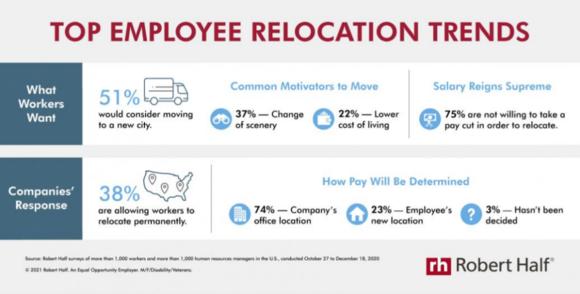Previously Published on News Break
In case you haven’t noticed, our economy has been re-opening since the introduction of vaccines. People are traveling again. Others are looking for work. And, hiring managers are back on the scene, recruiting for their latest openings — yet, so much of our regular hiring processes have changed.
Last month, one company reported that more than 29% of working professionals would quit their job if not allowed to continue working remotely and that 62% of long-term employees preferred employers that offered work from home opportunities in the future. Most have reported that working from home made them more productive, allowed them to focus on quality and that they were less stressed due to a more meaningful work-life balance, despite a deadly pandemic knocking at their front doors.
Robert Half, the World’s first and leading staffing agency, was also busy conducting their own studies, surveying more than 1000 workers, aged 18 and over, on the topic of relocation. More than 1,000 human resources managers were also polled, selected from companies in 28 major cities across the US.
The study showed that 51% of employees surveyed would strongly consider relocation should their company offer more long-term opportunities for working remotely. 4% of those surveyed had already moved by the time they were surveyed, often paying out-of-pocket expenses, themselves, just so they could secure easy employment or an opportunity they would not have had in the past.
A separate poll of human resource personnel would go on to suggest that many companies were open to the idea of an “anywhere workforce” with 50% of respondents reporting that their existing staff was able to relocate temporarily and another 38% noting that their company was in support of permanent moves, both in and out of town.
The Real Deal on Relocation
According to Allied, a national moving services company, young people, between the ages of 18 and 34, are most likely to relocate but admit that this data is ever-changing. Some of the most common reasons people relocate are in order to seek higher-paying jobs or career advancement within in their field (49.3%), especially if they work in a niche industry or when their industry is saturated. 20.5% of movers relocate to be closer to family or to transfer their position within an existing company (11.1%).
Now, people are leaving for other reasons, including high taxes and the growing cost of living. It’s getting more expensive to rent and harder to find high-paying jobs that would allow them to live comfortably. Silicon Valley, for example, is notorious for having one of the highest homeless working populations in our country. People are paid well, however, some are still living in an RV or vehicle. The pandemic has afforded them an opportunity to keep their jobs and settle down elsewhere in the country.
“51% of professionals would consider relocating,” according to The Robert Half Agency, “but only 25% would be willing to take a pay cut to do so.” Salary is obviously a factor and how much a company is willing to pay is another. Relocation fees can be expensive, especially when starting from scratch in a new city with few resources.
If the company pays for relocation, we see an increase in applicants, but if they don’t how does that factor? The quality of life in certain areas versus spending more time with our loved ones, during uncertainty, is another.
Common Motivators to Move
As previously discussed, the motivation to relocate may vary depending on the applicant, their industry, and what they hold dear. Personal budgets also play an important role on whether an employee is willing to relocate, whatsoever.
“While the motivation to relocate may vary,” highlights the survey, “common reasons cited by workers include a change of scenery (37%) and lower cost of living (22%). The research, however, shows that salary remains a priority for most professionals. And, 75% would not be willing to take a pay cut in their current job if they were to move, after all.”
“Pre-pandemic, job location was a big factor in where people chose to live,” states Paul McDonald, Senior Executive Director at The Robert Half Agency. “As many employees continue to work from home successfully, they’re considering how a move might improve their quality of life, particularly if they can keep their current salary.”
Negotiations Could be Sticky
Nearly four out of ten employers are now allowing the workforce to make a permanent move, whether in office or remotely. Employees are setting their sights on moving to a new city, but companies are forced to reconsider how they approach salary and benefits. Human resources may now play a new role in the re-allocation of resources, as they hire for new roles.
During the study, HR managers reported that, while they may pay one salary on-site, they may end up paying another. They have often said that salary will be determined by each office location (74%), the current workforce, and the employee’s new location (23%). However, certain companies have become synonymous with providing high pay to a higher quality workforce, and many don’t think that this should really change.
“While some employees are making temporary moves,” notes McDonald, “the anywhere workforce is here to stay. Adopting a flexible mindset will be critical for companies and professionals who want to thrive in a highly dynamic business environment.”
There is, of course, a significant cut in overhead for companies that hire remotely. Some companies may argue that while they’re known for paying higher salaries, the cost of living has often decreased for workers that moved away. There’s a larger pool of employees, and demand blows most salaries out of the water.
Why hire remotely?
The Timely Blog outlines The 6 Advantages of Hiring Remote Workers:
1. | Remote employees are much more productive.
According to Timely, the reasons for this are three-fold. Employees are less distracted by outside factors and able to practice unbroken, more focused work more often without the small talks of their colleagues and the pressure of 9-5 stigmatics.
Employees can work on their strengths without fear or insecurity. Flexible schedules benefit the workforce who works better outside of the standard workday and in their ideal work environment.
Finally, employees report feeling more valued by their superiors and more in control of their contributions. Their drive for autonomy grows, as well as communicating employer trust.
2. | There’s access to a wider pool of talent.
Though this is self-explanatory, employers now have the ability to fill voids in their hiring cycles, grow out their pipelines and build more successful plans for succession. Expanding the boundaries of employment, companies can break barriers often associated with language, capability, and talent. Some areas of the country, for example, may be saturated with technical professionals, while other areas may be in desperate need.
3. | The cost of doing business will decrease significantly.
The cost of operation is easily reduced. Employees have their own office space and pay their own utilities.
“Studies suggest,” states Timely, “that companies with remote workers save $10K per employee in real estate costs, alone. You scale back the office costs of furniture, bills, cleaners, and office supplies. You also tend to see fewer sick, which can cost $1,800 per employee, annually.” This reduces downtime, eliminating an upwards of eight hours per week on non-work-related activities, 20% of the standard workweek! Not to mention, the workforce is less fatigued by eliminating earlier waking hours and the headaches of morning transit.
4. | It costs less to be an employee.
Plus, there are quite a few reimbursements and tax credits available to those who qualify.
Timely reminds us that “Hiring remote workers doesn’t just benefit employers financially – it also reduces costs for workers, both financially and emotionally.” By eliminating the commute to and from the workplace, remote workers will save about $5,000 per year without factoring in the cost of regularly buying lunch out or feeling like they have to keep up with office fashions and trends.
Electricity, gas, phone bills, and equipment are often called the “hidden costs of working remotely.” But, depending on your relationship with the business, most of this can be reimbursed in the form of expenses, tax write-offs, or an elevated salary.
5. | Employee retention increases.
Timely’s research reveals that “95% of companies report that remote working has a big positive effect on employee retention: and that “two-thirds of workers say they’d take a new job if it had a better commute!”
6. | It’s greener.
The blog points out ways that we negatively affect our environment on a yearly basis:
- $20M in gas, burnt and polluting our air
- 54M tons of greenhouse gas emissions are released and, if eliminated, would be like taking 10M cars off the road
- 640M barrels of oil are secured, whether used or not, impacting our economy by $64B
- 119B miles are spending driving on highways a year
Will this trend last forever?
Robert Half predicts three workplace trends for 2021 and beyond.
- “The talent pool will become an ocean” — Hiring managers will expand their search outside of city limits and avoid wading a flood of resumes by partnering with staffing firms to gain direct, immediate access to top talents across industry.
- “Investments are shifting.” — Higher budgets will be allocated to technology in support of secure remote work environments, increasing communication and encouraging seamless collaboration amongst teams. Employee health and well-being programs and benefits will also be customized and reallocated, based on employee location.
- “Effective onboarding and offboarding are critical.” — “While virtual onboarding has already replaced the in-person orientation process at many organizations, employers also need to reimagine how they handle employee exits from a distance.”




